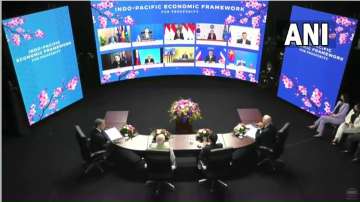US announces new Indo-Pacific Economic Framework to counter China, India signatory
Critics say the framework has gaping shortcomings. It doesn't offer incentives to prospective partners by lowering tariffs.

President Joe Biden on Monday launched the Indo-Pacific Economic Framework (IPEF) -- a new trade deal with 12 Indo-Pacific nations aimed at strengthening their economies. The new trade deal which excludes China is designed to restructure the supply chain globally for stability in commerce after disruptions caused by the pandemic and Russia's invasion of Ukraine.
Nations joining the US in the Indo-Pacific Economic Framework are Australia, Brunei, India, Indonesia, Japan, South Korea, Malaysia, New Zealand, the Philippines, Singapore, Thailand and Vietnam. Along with the United States, they represent 40% of world GDP.
The countries said in a joint statement that the pact will help them collectively “prepare our economies for the future” following disruptions caused by the coronavirus pandemic and the Russian invasion of Ukraine.
Biden and Japan PM Fumio Kishida were joined by Prime Minister Narendra Modi while representatives from the other countries appeared by video to help launch the pact. Modi was in Tokyo for Tuesday's meeting of the Quad, a security grouping that also includes the US, Japan and Australia.
The White House said the framework will help the United States and Asian economies work more closely on issues including supply chains, digital trade, clean energy, worker protections and anti-corruption efforts. The details still need to be negotiated among the member countries, making it difficult for the administration to say how this agreement would fulfil the promise of helping US workers and businesses while also meeting global needs.
What critics say
Critics say the framework has gaping shortcomings. It doesn't offer incentives to prospective partners by lowering tariffs or provide signatories with greater access to US markets. Those limitations may not make the US framework an attractive alternative to the Trans-Pacific Partnership, which still moved forward after the US bailed out. China, the largest trading partner for many in the region, is also seeking to join Trans-Pacific Partnership (TPP).
“I think a lot of partners are going to look at that list and say: That's a good list of issues. I'm happy to be involved,'” said Matthew Goodman, a former director for international economics on the National Security Council during President Barack Obama's administration. But he said they also may ask, “Are we going to get any tangible benefits out of participating in this framework?”
The White House announced plans to build the economic framework in October as a replacement for the Trans-Pacific Partnership, which the US dropped out of in 2017 under then-President Donald Trump.
New pact to compete with China
New pact comes at a moment when the administration believes it has the edge in its competition with Beijing.
The new pact comes at a moment when the administration believes it has the edge in its competition with Beijing. Bloomberg Economics published a report last week projecting US GDP growth at about 2.8% in 2022 compared to 2% for China, which has been trying to contain the coronavirus through strict lockdowns while also dealing with a property bust. The slowdown has undermined assumptions that China would automatically supplant the US as the world's leading economy.
“The fact that the United States will grow faster than China this year, for the first time since 1976, is a quite striking example of how countries in this region should be looking at the question of trends and trajectories,” said White House national security adviser Jake Sullivan.
The launch of the Indo-Pacific Economic Framework has been billed by the White House as one of the bigger moments of Biden's Asia trip and of his ongoing effort to bolster ties with Pacific allies. Through it all, administration officials have kept a close eye on China's growing economic and military might in the region.
Also Read | What’s in Biden’s Indo-Pacific Economic Framework. How it will benefit India - Explained